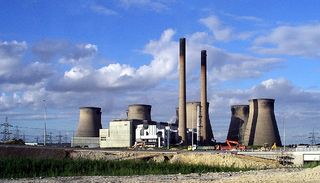Electrical generation: Difference between revisions
J.williams (talk | contribs) m (Reverted edits by J.williams (talk) to last revision by Jmdonev) |
m (1 revision imported) |
||
| (7 intermediate revisions by 4 users not shown) | |||
| Line 1: | Line 1: | ||
[[Category:Done | [[Category:Done 2020-02-29]] | ||
<onlyinclude>[[Electricity]] is an [[energy currency]], rather than an [[energy]] source, which means that '''electrical generation''' needs to start from a [[primary energy]] source like a [[fuel]] or a [[flow]]. These fuels and flows are usually turned into | [[Category:Translated to Spanish]] | ||
[[es:Generación de energía eléctrica]] | |||
[[Category:Translated to French]] | |||
[[fr:Production électrique]] | |||
[[File:ferrybridge.jpg|320px|thumb|Figure 1. A coal fired power plant in England. Coal plants are the single largest contributors to both the world's electrical generation and [[climate change]].<ref>Wikimedia Commons [Online], Available: https://upload.wikimedia.org/wikipedia/commons/7/76/Ferrybridge_%27C%27_Power_Station_-_geograph.org.uk_-_35089.jpg</ref>]] | |||
<onlyinclude>[[Electricity]] is an [[energy currency]], rather than an [[energy]] source, which means that '''electrical generation''' needs to start from a [[primary energy]] source like a [[fuel]] or a [[primary energy flow]]. These fuels and flows are usually turned into [[electric current]] which transmits [[electric power to the grid]].</onlyinclude> | |||
[[Power plant]]s are the most commonly used [[energy conversion technology]] to create electricity from primary energy. Common types of power plants include [[coal-fired power plant|coal]], [[nuclear power plant|nuclear]], and [[hydroelectric facility|hydro]]. While it is possible to have both [[AC electrical generation]] and [[DC generation|DC electrical generation]], almost all electricity that is produced with a [[generator]] is [[alternating current]]. Motion ([[kinetic energy]]) is converted into the [[electric field|electric]] and [[magnetic field]]s that create an [[electromotive force]], which makes current flow in a [[wire]]. This electricity usually travels through the [[electrical grid]] allowing some [[electrical device]] to use the energy in the [[electron]]s and then send the electrons back. This is what is meant by an [[electric circuit]], the electrons must be capable of making the round trip. | [[Power plant]]s are the most commonly used [[energy conversion technology]] to create electricity from primary energy. Common types of power plants include [[coal-fired power plant|coal]], [[nuclear power plant|nuclear]], and [[hydroelectric facility|hydro]]. While it is possible to have both [[AC electrical generation]] and [[DC generation|DC electrical generation]], almost all electricity that is produced with a [[generator]] is [[alternating current]]. Motion ([[kinetic energy]]) is converted into the [[electric field|electric]] and [[magnetic field]]s that create an [[electromotive force]], which makes current flow in a [[wire]]. This electricity usually travels through the [[electrical grid]] allowing some [[electrical device]] to use the energy in the [[electron]]s and then send the electrons back. This is what is meant by an [[electric circuit]], the electrons must be capable of making the round trip. | ||
==World electricity generation== | ==World electricity generation== | ||
The map below shows | The map below shows how different countries generate electricity from various primary energy sources. Click on the region to zoom into a group of countries, then click on the country to see where its electricity comes from. | ||
To explore a graph of world electricity use in the context of other energy uses, please click [[electricity#World electricity use|here]]. | To explore a graph of world electricity use in the context of other energy uses, please click [[electricity#World electricity use|here]]. | ||
<html><iframe class='charts-iframe' id='world-energy'></iframe></html> | <html><iframe class='charts-iframe' id='world-energy'></iframe> | ||
<script> | |||
if (window.location.href.indexOf('location=') != -1){ | |||
var pollutant = window.location.href.split('location=')[1].split('#')[0], | |||
list = document.getElementsByClassName('charts-iframe'), | |||
i,len = list.length; | |||
for (i = 0; i < len; i++){ | |||
list[i].className += ' location-'+location; | |||
} | |||
} | |||
</script> | |||
</html> | |||
== For Further Reading == | |||
For further information please see the related pages below: | |||
*[[Alternating current]] | |||
*[[Energy for electricity by country]] | |||
*[[Electrical grid]] | |||
*[[Electric generator]] | |||
* Or explore a [[Special:Random| random page!]] | |||
==References== | |||
{{Reflist}} | |||
[[Category:Uploaded]] | [[Category:Uploaded]] | ||
Latest revision as of 00:02, 27 September 2021

Electricity is an energy currency, rather than an energy source, which means that electrical generation needs to start from a primary energy source like a fuel or a primary energy flow. These fuels and flows are usually turned into electric current which transmits electric power to the grid.
Power plants are the most commonly used energy conversion technology to create electricity from primary energy. Common types of power plants include coal, nuclear, and hydro. While it is possible to have both AC electrical generation and DC electrical generation, almost all electricity that is produced with a generator is alternating current. Motion (kinetic energy) is converted into the electric and magnetic fields that create an electromotive force, which makes current flow in a wire. This electricity usually travels through the electrical grid allowing some electrical device to use the energy in the electrons and then send the electrons back. This is what is meant by an electric circuit, the electrons must be capable of making the round trip.
World electricity generation
The map below shows how different countries generate electricity from various primary energy sources. Click on the region to zoom into a group of countries, then click on the country to see where its electricity comes from.
To explore a graph of world electricity use in the context of other energy uses, please click here.
For Further Reading
For further information please see the related pages below:
- Alternating current
- Energy for electricity by country
- Electrical grid
- Electric generator
- Or explore a random page!
References
- ↑ Wikimedia Commons [Online], Available: https://upload.wikimedia.org/wikipedia/commons/7/76/Ferrybridge_%27C%27_Power_Station_-_geograph.org.uk_-_35089.jpg

